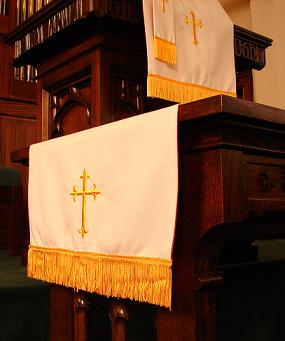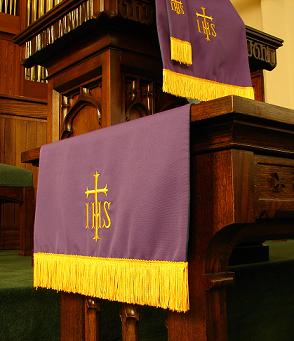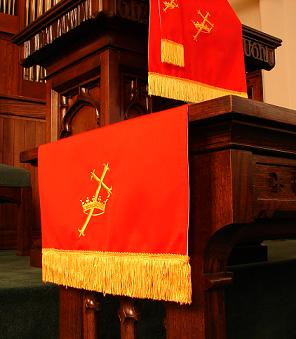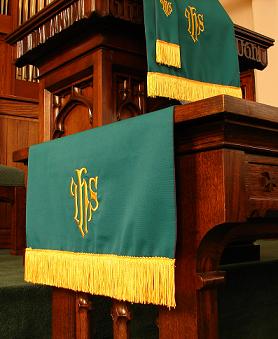THE COLORS OF THE SEASONS
Introduction
As we move through the church year, there are many symbols which the church uses to remind us of the significance of seasons and days. Colors are both expressive and reflective of mood and meaning. The color of vestments and paraments are among the most prominent symbols used in worship. As the colors change according to the seasons of the church year, they tell us much about who we are and what we believe. The colors serve to adorn the worship space and to call attention to the nature of the season or festival being celebrated.

WHITE
White symbolizes purity, holiness, and virtue, as well as respect and reverence. White is used for all high Holy Days and festival days of the Church year. The color of white marks the following:
- Eastertide
- Christmastide
- Epiphany (January 6)
- All Saints’ Day (November 1)
- Transitional Sundays in Ordinary Time:
- Baptism of our Lord
- Transfiguration of our Lord
- Trinity Sunday
- Christ the King

PURPLE
- Advent
- Lent; including:
- Ash Wednesday
- Holy Week

Red is the color of fire and so symbolizes the presence of God's Holy Spirit. Red is considered the color of the Church, since red can also symbolize the blood of martyrs. Red represents sacrifice because it signifies the shed blood of Christ's disciples who gave their lives as a witness to the glory of our risen Lord. The color of red marks the Day of Penecost. Also, in the the Reformed Tradition, as observed by the Presbyterian Church, red marks Reformation Sunday (the Last Sunday in October).

Because green is the color of new vegetation, it symbolizes living things in general and signifies the hope of new life. Green represents the promise of new life which is ours in the life of Jesus Christ our Lord. The color of green marks every day in Ordinary Time, except:
- Baptism of our Lord (which is white)
- Transfiguration of our Lord (which is white)
- Trinity Sunday (which is white)
- Christ the King (which is white)
- All Saints' Day (which is white)
- Reformation Sunday (which is red)

 Copyright © 2011-2014 First Presbyterian Church, Richmond, KY. All rights reserved.
Copyright © 2011-2014 First Presbyterian Church, Richmond, KY. All rights reserved.